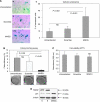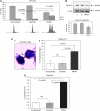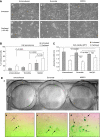Cellular senescence induced by aberrant MAD2 levels impacts on paclitaxel responsiveness in vitro
- PMID: 19935801
- PMCID: PMC2788249
- DOI: 10.1038/sj.bjc.6605419
Cellular senescence induced by aberrant MAD2 levels impacts on paclitaxel responsiveness in vitro
Erratum in
- Br J Cancer. 2010 Jan 19;102(2):456. Mosetto, M [corrected to Tosetto, M]
Abstract
Background: The mitotic arrest deficiency protein 2 (MAD2) is a key component of the mitotic spindle assembly checkpoint, monitoring accurate chromosomal alignment at the metaphase plate before mitosis. MAD2 also has a function in cellular senescence and in a cell's response to microtubule inhibitory (MI) chemotherapy exemplified by paclitaxel.
Methods: Using an siRNA approach, the impact of MAD2 down-regulation on cellular senescence and paclitaxel responsiveness was investigated. The endpoints of senescence, cell viability, migration, cytokine expression, cell cycle analysis and anaphase bridge scoring were carried out using standard approaches.
Results: We show that MAD2 down-regulation induces premature senescence in the MCF7 breast epithelial cancer cell line. These MAD2-depleted (MAD2) cells are also significantly replicative incompetent but retain viability. Moreover, they show significantly higher levels of anaphase bridges and polyploidy compared to controls. In addition, these cells secrete higher levels of IL-6 and IL-8 representing key components of the senescence-associated secretory phenotype (SASP) with the ability to impact on neighbouring cells. In support of this, MAD2 cells show enhanced migratory ability. At 72 h after paclitaxel, MAD2 cells show a significant further induction of senescence compared with paclitaxel naive controls. In addition, there are significantly more viable cells in the MAD2 MCF7 cell line after paclitaxel reflecting the observed increase in senescence.
Conclusion: Considering that paclitaxel targets actively dividing cells, these senescent cells will evade cytotoxic kill. In conclusion, compromised MAD2 levels induce a population of senescent cells resistant to paclitaxel.
Figures






Similar articles
-
Dependence of paclitaxel sensitivity on a functional spindle assembly checkpoint.Cancer Res. 2004 Apr 1;64(7):2502-8. doi: 10.1158/0008-5472.can-03-2013. Cancer Res. 2004. PMID: 15059905
-
Low MAD2 expression levels associate with reduced progression-free survival in patients with high-grade serous epithelial ovarian cancer.J Pathol. 2012 Apr;226(5):746-55. doi: 10.1002/path.3035. Epub 2012 Jan 17. J Pathol. 2012. PMID: 22069160 Free PMC article.
-
p31comet Induces cellular senescence through p21 accumulation and Mad2 disruption.Mol Cancer Res. 2009 Mar;7(3):371-82. doi: 10.1158/1541-7786.MCR-08-0056. Epub 2009 Mar 10. Mol Cancer Res. 2009. PMID: 19276188
-
Too MAD or not MAD enough: The duplicitous role of the spindle assembly checkpoint protein MAD2 in cancer.Cancer Lett. 2020 Jan 28;469:11-21. doi: 10.1016/j.canlet.2019.10.005. Epub 2019 Oct 5. Cancer Lett. 2020. PMID: 31593803 Review.
-
Structural activation of Mad2 in the mitotic spindle checkpoint: the two-state Mad2 model versus the Mad2 template model.J Cell Biol. 2006 Apr 24;173(2):153-7. doi: 10.1083/jcb.200601172. J Cell Biol. 2006. PMID: 16636141 Free PMC article. Review.
Cited by
-
Overexpression of the microRNA miR-433 promotes resistance to paclitaxel through the induction of cellular senescence in ovarian cancer cells.Cancer Med. 2015 May;4(5):745-58. doi: 10.1002/cam4.409. Epub 2015 Feb 15. Cancer Med. 2015. PMID: 25684390 Free PMC article.
-
Relationship between serum response factor and androgen receptor in prostate cancer.Prostate. 2015 Nov;75(15):1704-17. doi: 10.1002/pros.23051. Epub 2015 Aug 7. Prostate. 2015. PMID: 26250344 Free PMC article.
-
Too early to say, "no targeting of mitosis!".Nat Rev Clin Oncol. 2011 May 17;8(7):444; author reply 444. doi: 10.1038/nrclinonc.2010.228-c1. Nat Rev Clin Oncol. 2011. PMID: 21587220 No abstract available.
-
The role of the MAD2-TLR4-MyD88 axis in paclitaxel resistance in ovarian cancer.PLoS One. 2020 Dec 28;15(12):e0243715. doi: 10.1371/journal.pone.0243715. eCollection 2020. PLoS One. 2020. PMID: 33370338 Free PMC article.
-
The effect of iron on the expression levels of calcium related gene in cisplatin resistant epithelial ovarian cancer cells.Explor Target Antitumor Ther. 2021;2(4):309-322. doi: 10.37349/etat.2021.00048. Epub 2021 Aug 30. Explor Target Antitumor Ther. 2021. PMID: 36046755 Free PMC article.
References
-
- Bodnar AG, Ouellette M, Frolkis M, Holt SE, Chiu CP, Morin GB, Harley CB, Shay JW, Lichtsteiner S, Wright WE (1998) Extension of life span by introduction of telomerase into normal human cells. Science 279: 349–352 - PubMed
-
- Chang BD, Xuan Y, Broude EV, Zhu H, Schott B, Fang J, Roninson IB (1999) Role of p53 and p21waf1/cip1 in senescence-like terminal proliferation arrest induced in human tumor cells by chemotherapeutic drugs. Oncogene 18(34): 4808–4818 - PubMed
Publication types
MeSH terms
Substances
LinkOut - more resources
Full Text Sources
Medical

